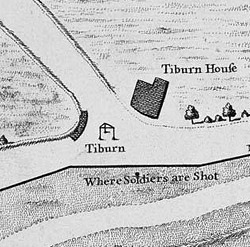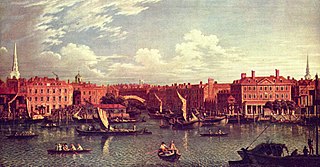
Grays Antique Market is an antiques market in Mayfair, London, close to Bond Street station. [1] Dealers specialise in antiques, jewellery, watches and collectables. The centre is home to nearly 100 dealers on 2 levels. [2]

Grays Antique Market is an antiques market in Mayfair, London, close to Bond Street station. [1] Dealers specialise in antiques, jewellery, watches and collectables. The centre is home to nearly 100 dealers on 2 levels. [2]
The Grays dealers are situated in a grade-two listed building on Davies Street designed by the Edwardian architect Reginald Bloomsfield. The building was originally commissioned by water closet manufacturers, John Bolding and Son. In 1977 it was restored by Bennie Gray, the founder of Grays from a near-derelict site to the former glories of the water closet showroom. [3]

The Mews section is now closed and many of the dealers from that part of the building now trade from the sister company Alfies Antique Market located in Marylebone. The Mews section of Grays was built circa 1900 and was also taken over by Bolding in 1931. [4]
The basement of the Mews had been under six feet of water for many years,[ citation needed ] and on closer inspection it was found that a spring arose from one end of the building.[ citation needed ] Now renovated, the shop claims that the water flowing through a conduit in its basement is the River Tyburn, [5] which rises in Hampstead and flows underground towards the River Thames. [6] The Londonist website describes this suggestion as "fanciful", as the modern Tyburn is contained in a conduit. [7]

Tyburn was a manor (estate) in the county of Middlesex, England, one of two which were served by the parish of Marylebone. Tyburn took its name from the Tyburn Brook, a tributary of the River Westbourne. The name Tyburn, from Teo Bourne, means 'boundary stream'.

Mayfair is an affluent area in the West End of London towards the eastern edge of Hyde Park, in the City of Westminster, between Oxford Street, Regent Street, Piccadilly and Park Lane. It is one of the most expensive districts in the world.

The River Fleet is the largest of London's subterranean rivers, all of which today contain foul water for treatment. It has been used as a sewer since the development of Joseph Bazalgette's London sewer system in the mid 19th century with the water being treated at Beckton Sewage Treatment Works. Its headwaters are two streams on Hampstead Heath, each of which was dammed into a series of ponds—the Hampstead Ponds and the Highgate Ponds—in the 18th century. At the southern edge of Hampstead Heath these descend underground as sewers and join in Camden Town. The waters flow 4 miles (6 km) from the ponds.

The Westbourne or Kilburn is a culverted small River Thames tributary in London, rising in Hampstead and Brondesbury Park and which as a drain unites and flows southward through Kilburn and Bayswater to skirt underneath the east of Hyde Park's Serpentine lake then through central Chelsea under Sloane Square. It passes centrally under the south side of Royal Hospital Chelsea's Ranelagh Gardens before discharging into Inner London's old-fashioned, but grandiose combined sewer system, with exceptional discharges into the Inner London Tideway. Since the latter 19th century, the population of its catchment has risen further but to reduce the toll it places on the Beckton Sewage Treatment Works and related bills its narrow basin has been assisted by private soakaways, and public surface water drains. Its depression has been replaced with and adopted as a reliable route for a gravity combined sewer. The formation of the Serpentine relied on the water, a lake with a long, ornate footbridge and various activities associated, which today uses little-polluted water from a great depth.


The River Tyburn was a stream in London, England. Its main successor sewers emulate its main courses, but it resembled the Colne in its county of Middlesex in that it had many distributaries. It ran from South Hampstead, through Marylebone, Mayfair, St James's parish/district and Green Park to meet the tidal Thames at four sites, grouped into pairs. These pairs were near Whitehall Stairs, and by Thorney Street, between Millbank Tower and Thames House. Its much smaller cousin, the Tyburn Brook, was a tributary of the Westbourne and the next Thames tributary.

Brook Street is an axial street in the exclusive central London district of Mayfair. Most of it is leasehold, paying ground rent to and seeking lease renewals from the reversioner, that since before 1800, has been the Grosvenor Estate. Named after the Tyburn that it crossed, it was developed in the first half of the 18th century and runs from Hanover Square to Grosvenor Square. The western continuation is called Upper Brook Street; its west end faces Brook Street Gate of Hyde Park. Both sections consisted of neo-classical terraced houses, mostly built to individual designs. Some of them were very ornate, finely stuccoed and tall-ceilinged, designed by well known architects for wealthy tenants, especially near Grosvenor Square, others exposed good quality brickwork or bore fewer expensive window openings and embellishments. Some of both types survive. Others have been replaced by buildings from later periods.

Hobson's Conduit, also called Hobson's Brook, is a watercourse that was built from 1610 to 1614 by Thomas Hobson and others to bring fresh water into the city of Cambridge, England from springs at Nine Wells, a Local Nature Reserve, near the village of Great Shelford. It is now a Scheduled Ancient Monument and historical relic. The watercourse currently runs overground until Cambridge University Botanic Garden and Brookside, where it is at its widest. At the corner of Lensfield Road stands a hexagonal monument to Hobson, which once formed part of the market square fountain, and was moved to this location in 1856, after a fire in the Market. The flow of water runs under Lensfield Road, and subsequently runs along both sides of Trumpington Street in broad gutters towards Peterhouse and St Catharine's College, and also St Andrew's Street. The conduit currently ends at Silver Street.
Lisson Grove is a street and district in Marylebone, City of Westminster, London. The neighbourhood contains a few important cultural landmarks, including Lisson Gallery, Alfies Antique Market, Red Bus Recording Studios, the former Christ Church, now the Greenhouse Centre, and the Seashell of Lisson Grove.

The Great Conduit was a man-made underground channel in London, England, which brought drinking water from the Tyburn to Cheapside in the City.

Camden Passage is a pedestrian street, close to the Angel tube station off Upper Street in the London Borough of Islington. The passage is known for its antique shops, markets and its array of independent shops, cafes, and restaurants.

Shepherd Market is a small business-lined precinct featuring two small squares, one with a northern recess in Mayfair, in the West End of London, built up between 1735 and 1746 by Edward Shepherd on the open ground then used for the annual fair from which Mayfair derives; it does so with the east end of Shepherd Street which is also broad-pavemented. It is between Piccadilly and Curzon Street and has a village-like atmosphere. It was associated with upmarket prostitutes from its building up until at least the 1980s. In the 1920s, it hosted leading writers and artists such as Anthony Powell, Michael Arlen and Sophie Fedorovitch. Jeffrey Archer met Monica Coghlan here in the 1980s.

Lamb's Conduit Street is a street in Holborn in the West End of London. The street takes its name from Lambs Conduit, originally known as the Holborn Conduit, a dam across a tributary of the River Fleet.

Marylebone is a district in the West End of London, in the City of Westminster. Oxford Street, Europe's busiest shopping street, forms its southern boundary.

Alfies Antique Market is a large indoor market located on Church Street in Lisson Grove, London. It houses over seventy-five dealers offering antiques; including silver, furniture, jewellery, paintings, ceramics, glass and vintage clothing.

Weymouth Street lies in the Marylebone district of the City of Westminster and connects Marylebone High Street with Great Portland Street. The area was developed in the late 18th century by Henrietta Cavendish Holles and her husband Edward Harley, 2nd Earl of Oxford. This part of Marylebone originally belonged to the Manor of Tyburn which existed at the time of the Domesday Book (1086).

The Old Red Lion is a pub at 72 High Holborn on the corner with Red Lion Street, Holborn, London.

Marylebone Lane is one of the original streets of the Marylebone district of the City of Westminster, London. It runs from Oxford Street in the south to Marylebone High Street in the north, its winding shape following the course of the River Tyburn that it once ran alongside and pre-dating the grid pattern of the other streets in the area. Today the lane is largely composed of small shops, cafes and restaurants with some small apartment blocks. There are some larger commercial buildings at the southern end near Oxford Street.
This is a list of the etymology of street names in the London district of Mayfair, in the City of Westminster. It utilises the generally accepted boundaries of Mayfair viz. Marble Arch/Cumberland Gate and Oxford Street to the north, Regent Street to the east, Piccadilly to the south and Park Lane to the west.

Motcomb Street is a street in the City of Westminster's Belgravia district in London. It is known for its luxury fashion shops, such as Christian Louboutin shoes, Stewart Parvin gowns, and the jeweller Carolina Bucci, and was the location of the original Pantechnicon department store.